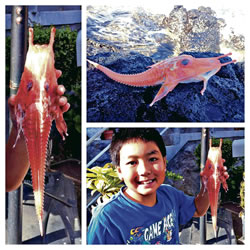A True Creature From The Deep

Travis Toyama and his ‘Creepy Christmas Catch. Photos courtesy Shari Matsuda and Ashlyn Toyama
Travis Toyama returned to Jarrett Middle School in Palolo Valley following his long winter break with a fishing tale many of his sixth-grade classmates probably didn’t believe.
I can only imagine what the conversation sounded like in class.
“Hey guys, I found this fish at the Makapuu tide pools during Christmas break and it looks like a spiny creature from outer space. It is so cool.”
“Oh yeah, where is it?” “In my freezer.”
“Yeah, right, whatever.” “I promise.”
Well, guess what? It’s no tale. The 11-year-old Toyama really did find a prehistoric-looking fish at the Makapuu tide pools and, according to his mom Laura, it really is in the family freezer.
“It looks so strange,” laughs Laura. “It looks like an alien species or something.”
According to Laura, Travis is an avid fisherman who goes fishing “every chance he gets.” She says he recently got a chance when his Aunt Shari Matsuda took him and his cousin Kirra Kawai to the Makapuu tide pools. Travis was armed with his fishing gear and net when he spotted a bizarre creature floating in the water.
“A few people were looking at it, but nobody wanted to touch it,” chuckles Laura. “Travis asked everyone around if it was OK if he took it, and they said go ahead. So he grabbed his net and scooped it up. When he put it on the rock, he realized it was already dead. He brought it home to show us and then he put it in our freezer.”
The Toyamas had no idea what the mysterious spiny creature was, so they sent several photographs to the Waikiki Aquarium. Acting curator Richard Klobuchar quickly provided them with an answer.
“The fish pictured is called a slenderhorn amored gurnard (Satyrichthys engyceros) and is related to the more common, shallow water flying gurnards,” says Klobuchar, who is an aquarium biologist and a coral and invert specialist. “The armored gurnards are typically found in deeper waters about 600 to 1,600 feet off the Hawaiian Islands, Johnston Island and southern Japan.”
Laura Toyama says Klobuchar didn’t know how the fish got to the tide pools but he told her they have been found to feed primarily on small shrimps and larval fish. He says the short branches and barbels coming off the anterior portion of the head are presumed to function in the detection of prey items.
“I wouldn’t necessarily call this fish rare,” says Klobuchar. “It is just not as common to the shallower scuba/snorkeling depths that most of the general public enjoys on a day-today basis.”
Laura Toyama says Travis initially wanted to find a professional fish taxidermist, hoping to mount his catch on his wall, “but now he wants to make it a gyotaku fish print.”
The family has contacted Naoki, a world-famous gyotaku artist who is known for the traditional form of Japanese fish printing or rubbing, dating from the mid-19th century.
“Naoki said he’s very interested in doing something with us,” says Laura. “He says he’s never done one with this kind of fish and he wants to try it because it sounds really neat. We’re concerned the tail is so spiny from top to bottom that it might cut through the paper.”
Laura Toyama says her son’s prized catch has made him a mini-celebrity with family and friends. She says their pictures have circulated everywhere and a few people are even using the photos as screen savers on their phones and computers.
“This has been such a great experience for him,” says Laura. “He is so happy. We’re still laughing.”
Now if she can just get that alien out of her freezer.



